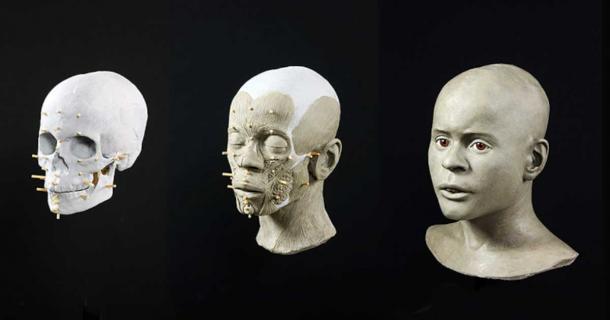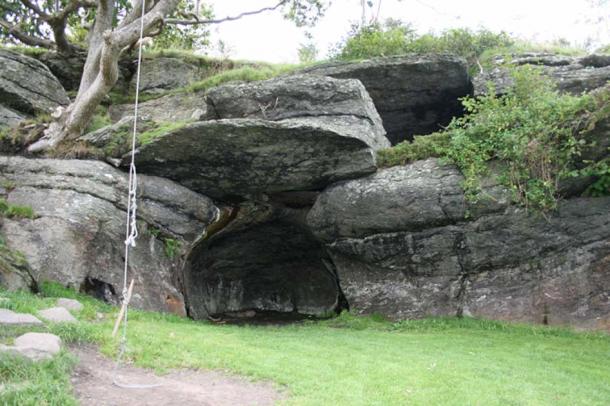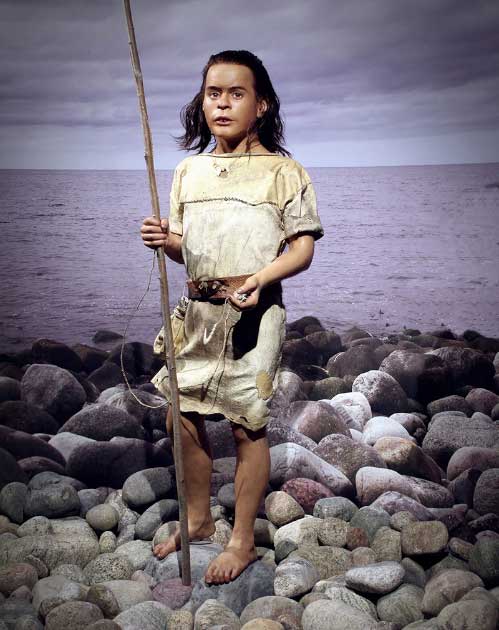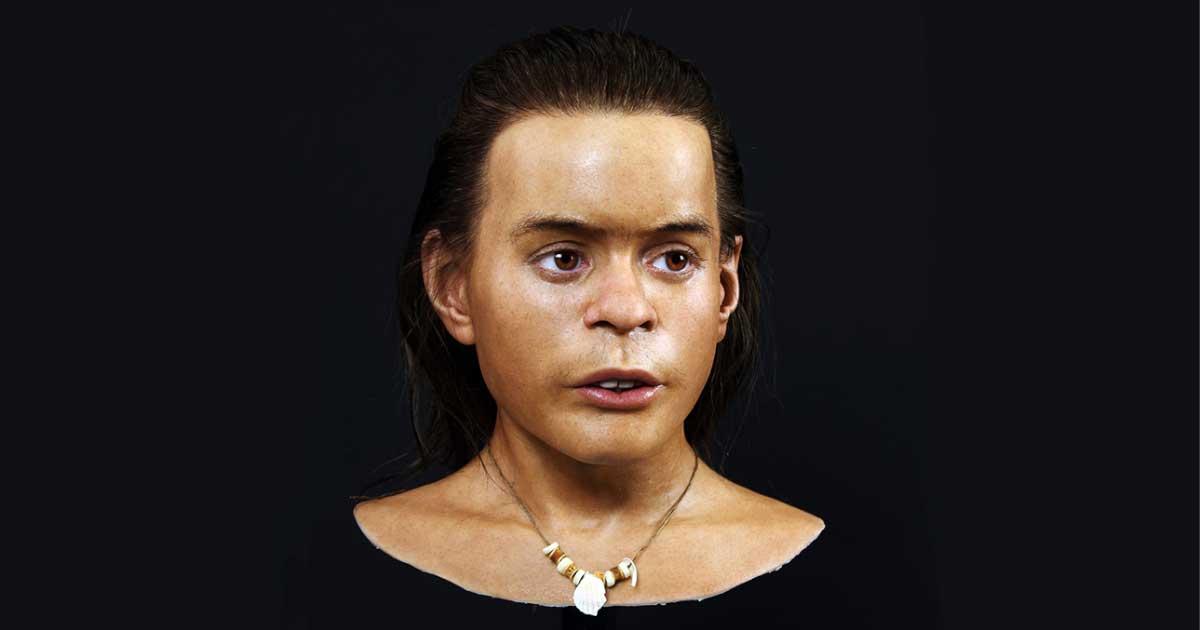Meet Vistegutten: AI Resurrects Face of Stone Age Teen Found in Norway
In 1907, the remains of a teenage boy who lived over 8,300 years ago were discovered in a Mesolithic cave located in Randaberg on the west coast of Norway. Dubbed as “one of the oldest skeletons ever found in Norway,” the fascinating reconstruction of the boy, known as Vistegutten, has recently been unveiled at the Hå Gamle Prestegard Museum.
Using a novel reconstruction technique, this work has breathed new life into the 15-year-old who has been remembered for having an “unusual skull.” The reconstruction has also provided a glimpse into the life of a Stone Age teenager and contributed to our understanding of the region's history.

Vistegutten’s skeletal remains were found in a cave once used by Mesolithic hunter-gatherers. The teenager’s skeleton on display at the Archaeological Museum in Stavanger. (Terje Tveit / The Museum of Archaeology / University of Stavanger / CC BY-SA 3.0)
Using Artificial Intelligence to Reconstruct the Face of Vistegutten
Vistegutten, or “the boy from Viste,” was short for his age and era, standing at only 4 feet 1 inches (125 cm) tall. He also had a condition known as scaphocephaly, which caused his skull to grow backward instead of sideways, giving him an unusual appearance. He did not suffer from any kind of developmental disorder or intellectual disability, and was a healthy boy, all things considered.
- Forensic Facial Reconstruction: The Journey to Connect with our Ancestors
- Modern Forensic Science Helps Crack Details of 700-year-old “Cold Case” in Italy
“Either he was placed like this after his death, or he actually died in this position,” explained the Swedish forensic artist Oscar Nilsson, who created the boy's likeness. “This can give the impression of a lonely boy, waiting in vain for his friends and family to show up… but we know nothing about how he died,” said Nilsson in an email exchange with Live Science.
Artificial Intelligence (AI) art has recently been doing the rounds in the visual arts sphere and is popularly used for things like AI portrait generation, but recently, historians and archaeologists have been using the tech to reconstruct historical figures and faces. This has come in particularly handy where the recovered evidence has not been sufficient to follow traditional reconstruction techniques, as in the case of Vistegutten.

The forensic artist Oscar Nilsson invested many months in creating the reconstruction of Vistegutten based on the boy’s skull. (Oscar Nilsson)
Reconstruction Uses Artistic Judgment to Create Vistegutten’s Face
For instance, a few months ago, a team of Swedish coroners and artists worked together to reconstruct the face of a 4,000-year-old Stone Age woman, while a man who lived 8,000 years ago had his face reconstructed previously. Recently, researchers attempted to reconstruct the face of a woman who was thought to be a man, reports Science Post.
Nilsson has previously worked on other facial reconstructions of ancient individuals. The work done to reconstruct the face of Vistegutten provides a glimpse into what this Stone Age teenager may have looked like and allows modern viewers to connect with a human who lived thousands of years ago.
Nilsson also noted that the teenager's lower jaw was smaller than average, and his teeth were in relatively good condition. The boy's hair color, eye color and skin tone are unknown, so Nilsson used his artistic judgment to make a “neutral and believable” face that wouldn't look out of place in the museum exhibit. The reconstruction shows the boy with short, curly hair and a serious expression, his head tilted slightly downward as if in contemplation.
The boy's remains were found leaning against a cave wall, leading some to speculate that he died alone. However, there is no evidence to support this theory and it is not known for certain how he died. One such theory suggests that his death was rather tragic, with speculation that he lost his balance as he was clutching a fishing rod.

The remains of the teenage boy known as Vistegutten was found in a cave in western Norway (Jarvin Jarle Vines / CC BY-SA 3.0)
Vistegutten’s Final Resting Place Offers Glimpse of Mesolithic Life
The boy’s physique and the remains at the site suggest that food was aplenty. “The sheer volume of animal remains found at the site also attests to a plentiful food supply,” said Sean Dexter Denham, an osteologist at the Museum of Archaeology at the University of Stavanger in Norway who helped analyze the skeleton.
The cave is filled with evidence of ancient human activity, including kitchen waste, bone ornaments, and various fishing tools such as hooks, harpoons, and barbed bone points. This suggests that the cave was a site of human habitation and activity, where people lived, worked, cooked and slept.

The forensic artist paid a lot of attention to details to truly bring Vistegutten to life. (Oscar Nilsson)
The artifacts found in the cave offer a glimpse into the daily lives and practices of ancient humans in the Mesolithic era. For example, the presence of fishing tools suggests that fishing was an important source of food for the people who lived in the cave. The bone ornaments, on the other hand, suggest that these people had a sense of aesthetic appreciation and may have used personal adornments as a means of self-expression or social status.
- Facing the Facts: Just How Accurate Are Facial Reconstructions?
- Axe-Wounded Visby Warrior Brought to Life Over 600 Years Later
AI is Taking the World by Storm
Artificial intelligence is changing the world as we know it. Innovations such as ChatGPT, AI image generators, and text-to-speech tools are advancing at blazing speed, and the field of history and archaeology is no exception. AI is now being used to analyze and interpret artifacts, decode ancient scripts, digitally reconstruct archaeological sites, and piece together what our ancient ancestors once looked like.
Once again, advanced facial reconstruction has provided a window into ancient history, this time into the world of the Norwegian boy known as Vistegutten. All in all, the discovery of both the cave and the child are a reminder that people in the past were very much like people in contemporaneous times, even though they inhabited a world that was very different from the modern one. Meanwhile his facial reconstruction allows us to come face-to-face with Vistegutten in a way that wasn’t possible before.
Top image: Facial reconstruction of Vistegutten by forensic artist Oscar Nilsson. Source: Oscar Nilsson
By Sahir Pandey
References
Buenconsejo, J. 15 February 2023. “Reconstruction of 'Vistegutten' Boy Reveals Adolescent With Deformed Skull Who Might Have Been Alone in a Cave as He Died” in The Science Times. Available at: https://www.sciencetimes.com/articles/42418/20230215/reconstruction-vistegutten-boy-reveals-adolescent-deformed-skull-who-alone-cave.htm
Geggel, L. 15 February 2023. “Stunning reconstruction reveals 'lonely boy' with deformed skull who died in cave in Norway 8,300 years ago” in Live Science. Available at: https://www.livescience.com/stunning-reconstruction-reveals-lonely-boy-with-deformed-skull-who-died-in-cave-in-norway-8300-years-ago
Louvet, B. 16 February 2023. “What did this young man's face look like 8,300 years ago” in Sciencepost. Available at: https://sciencepost.fr/a-quoi-ressemblait-visage-jeune-homme-il-y-a-8300-ans/





















Comments
Are you kidding me here? The wide nose and dark skin in the cold world? And the no shoes just to top it off? Not funny. So not funny. Go back and do it again because I am not buying the BS.
Bert Dahl
The theory that blonde hair was caused by a fairly recent mutation might be the weakest theory ever. It’s not taken seriously; it’s more a whimsical hypothesis that has not been tested. And it’s utterly illogical, ...unless you want to lay down the logic on it – how all the blondes wound up way up North, in light of the ancient Greek texts and depictions of their golden-haired ‘gods’. For one, blonde is a natural shade, like dirty blonde or strawberry blonde or brownish, all a variation on one gene of fair-haired (modern northern European) people, who probably exclusively roamed the Earth prior to the Ice Age, and prior to the arrival (about 8k BC) of the self-described ‘black-headed’ (black haired) people of ancient Sumer, who went on the create the Semite races (as per Genesis and Sitchin), who were called ‘semites’ by the ancient Greeks, meaning semi-man, or the hybrid from Annunaki/fallen angels taking fair-haired aboriginal wives. The hair color distinctions could all be easily confirmed (crime labs do it regularly), which along with accurately dated migrations, via broad and thorough modern DNA analyses of the ancient human remains. There are some studies on that already, focusing on mitochrondian DNA (female genetics), which suggest the areas around the Med, such as Carthage, were, 1k BC or so, home to northern European type people upon the arrival of the black-headed/semites, whereupon the demographic quickly changed. But those studies DO NOT focus on hair color (yet). Of course, the results would certainly require a big change in many prominent theories, which could be disturbing to some, so there is that reluctance. As for ‘Nordic’, just google it.
Is the association with Hitler meant to silence the discussion? I get that sometimes. But the quest for truth creates a stronger motivation. Forward we must go!
Nobody gets paid to tell the truth.
Genes expressing blue eyes /blonde hair really don't become widespread until approx 7,000 years ago. So Pete that's quite an accurate presentation. As for "Nordic peoples" who on earth are you talking about? Sounds like you've researched from a companion volume to Mein Kampf. Don't suppose you could update your "science" from the 1930s?
It's well beyond dubious to pursue any facial reconstruction WITHOUT sequencing the DNA to determine hair and eye color, let alone many other characteristics of the flesh and cartilage. What they came up with as a result is 100% driven by political correctness, or just trying to further bolster dubious anthropological theories about the Nordics, the fair-haired aboriginals who survived the Ice Age, and the dark-haired, Roman/Golden Horde, etc., migrants that invaded their lands and stayed as tyrants - beginning only a couple thousand years ago. As I have said, and I’ll keep saying, the best and probably only way to learn what an ancient person really looked like is to sequence the DNA (crime labs do it all the time) and run it against the living database to match it up with the closest living person. That will tell you all you need to know, with no guesswork.
Nobody gets paid to tell the truth.